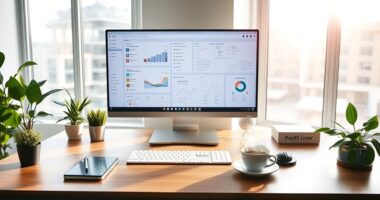Harnessing big data helps you make smarter operational decisions by enabling rapid analysis of vast information, spotting patterns, and forecasting trends. Predictive analytics allow you to anticipate customer needs and optimize supply chains, while data visualization makes complex insights easy to understand and act on. Real-time data streams ensure you respond quickly to changes, boosting agility and efficiency. Keep exploring to discover how integrating these tools can transform your organization’s decision-making capabilities.
Key Takeaways
- Utilize big data analytics to identify operational inefficiencies and optimize resource allocation.
- Implement predictive analytics to forecast demand, prevent issues, and enhance supply chain management.
- Use data visualization tools to monitor real-time KPIs and facilitate quick decision-making.
- Integrate predictive insights with visual dashboards for proactive operational adjustments.
- Leverage data-driven insights to improve responsiveness, reduce costs, and gain competitive advantage.

Have you ever wondered how organizations make faster, smarter decisions today? The answer lies in leveraging big data through advanced tools like predictive analytics and data visualization. These technologies enable you to process massive amounts of information quickly, uncover patterns, and make informed choices that drive operational success. Predictive analytics, in particular, helps you forecast future trends based on historical data, empowering you to anticipate customer needs, optimize supply chains, and prevent potential issues before they escalate. Instead of reacting to problems after they occur, you can proactively address them, saving time and resources.
Leveraging big data with predictive analytics and data visualization enables smarter, faster, and proactive organizational decision-making.
Data visualization plays a vital role in this decision-making process by transforming complex data into clear, digestible visuals. When you see charts, graphs, or heat maps, you can grasp insights at a glance, making it easier to identify correlations and outliers that might otherwise go unnoticed. Visualization tools make data accessible to all stakeholders, regardless of technical expertise, fostering better communication and collaboration within your team. They also enable you to quickly spot trends, monitor key performance indicators, and assess the impact of your strategies in real-time.
By integrating predictive analytics with data visualization, you create a powerful feedback loop. For example, you can project future sales based on seasonal patterns and then visually track actual performance against those forecasts. This combination allows you to adjust your operations swiftly, whether it’s reallocating resources, modifying marketing campaigns, or improving customer service. The ability to visualize predictive insights helps you build a more agile organization capable of adapting to changing market conditions.
Furthermore, these tools enhance decision-making accuracy by reducing reliance on intuition alone. Instead, you base your choices on data-driven evidence, increasing confidence in your strategies. When you have access to real-time data streams and intuitive visual dashboards, you can identify issues as they happen and implement corrective actions immediately. This agility not only improves efficiency but also enhances your organization’s responsiveness to external factors such as economic shifts or competitive pressures.
In essence, harnessing big data with predictive analytics and data visualization transforms your operational decision-making from a reactive to a proactive process. It enables you to make smarter, faster decisions grounded in evidence, ultimately giving your organization a competitive edge. By continuously analyzing data and visualizing insights, you stay ahead of the curve, ensuring your operations are optimized and aligned with your strategic goals. This approach isn’t just about managing data; it’s about turning data into your most valuable strategic asset. Additionally, understanding Kia Tuning options can help automotive businesses optimize vehicle performance and customer satisfaction, illustrating how detailed data and insights influence specialized fields.
Frequently Asked Questions
How Can Small Businesses Leverage Big Data Effectively?
You can leverage big data effectively by focusing on customer segmentation to understand your audience better and tailor your marketing efforts. Use predictive analytics to forecast trends and customer behavior, helping you make smarter decisions quickly. Invest in simple tools that analyze your data, and continuously monitor results. By applying these strategies, you’ll optimize operations, improve customer satisfaction, and stay competitive even with limited resources.
What Are Common Challenges in Implementing Big Data Solutions?
You face challenges like data integration and scalability as you implement big data solutions. While integrating diverse data sources sounds straightforward, it often proves complex, causing delays. Scalability challenges arise as your data grows, making storage and analysis harder. Balancing these hurdles requires careful planning and robust infrastructure. By addressing these issues early, you can harness big data effectively, turning obstacles into opportunities for smarter, more informed decisions.
How Does Data Privacy Impact Big Data Analytics?
Data privacy considerably impacts your big data analytics by requiring data anonymization to protect individuals’ identities. You must guarantee regulatory compliance, like GDPR or CCPA, which governs how you collect, store, and analyze data. Privacy concerns can limit your data access and sharing, demanding stricter controls. By prioritizing data privacy, you safeguard trust, avoid legal penalties, and ensure your analytics efforts remain ethical and compliant with evolving privacy standards.
What Skills Are Essential for Big Data Analysts?
Think of yourself as a detective in a vast data jungle. You need strong skills like data visualization to make complex insights clear and statistical modeling to predict trends accurately. These skills help you turn raw data into actionable decisions. You must also be curious, detail-oriented, and proficient in tools like SQL and Python. Mastering these abilities guarantees you can navigate big data effectively and support smarter operational choices.
How Can Organizations Measure the ROI of Big Data Initiatives?
You can measure the ROI of big data initiatives by conducting cost analysis to compare expenses against benefits gained. Focus on data valuation by evaluating how data-driven decisions improve efficiency, customer satisfaction, or revenue. Track key performance indicators and compare pre- and post-implementation metrics. This helps you quantify tangible returns, ensuring your big data investments deliver measurable value and justify ongoing or future efforts.
Conclusion
By harnessing big data, you open a doorway to insight as vast as the universe, guiding your decisions with the clarity of a starry night. It’s like having a compass in the fog—illuminating your path amid uncertainty. Embrace these insights, and watch your operations transform from a tangled web into a well-oiled machine. With data as your trusted navigator, you’ll steer confidently toward success, turning complexity into clarity with every decision you make.









